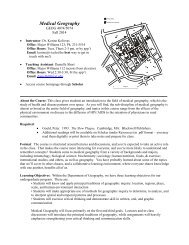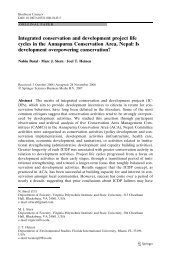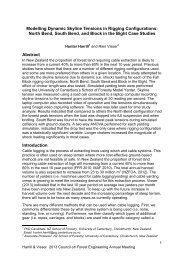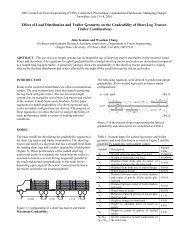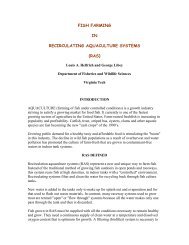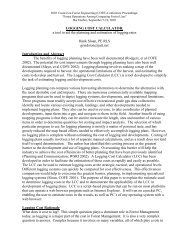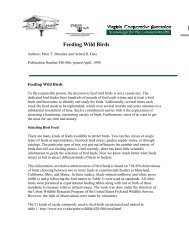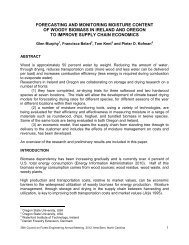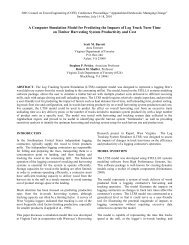Combining slash bundling with in-woods grinding operations
Combining slash bundling with in-woods grinding operations
Combining slash bundling with in-woods grinding operations
You also want an ePaper? Increase the reach of your titles
YUMPU automatically turns print PDFs into web optimized ePapers that Google loves.
Conclusion<br />
This study evaluated harvest<strong>in</strong>g productivity and cost of a woody biomass recovery system us<strong>in</strong>g<br />
a <strong>slash</strong> bundler. Productivity for different mach<strong>in</strong>es varied from 8 to 42 BDT/PMH, <strong>with</strong> a total<br />
production of 280.7 BDT over 70.2 hours. Production cost ranged from $2.99 to $17.97/BDT for<br />
different system components, <strong>with</strong> a total system production cost of $60.98/BDT at 28.95%<br />
moisture content.<br />
The bundler tested on ground based clearcut sites performed well produc<strong>in</strong>g 29-37 10ft bundles<br />
per productive mach<strong>in</strong>e hour. Slash pile arrangement and material size were found to have a<br />
significant effect on productivity of <strong>bundl<strong>in</strong>g</strong>. Pile class 3 (typical size material, side-cast piled)<br />
was found to be the most effective pile type when consider<strong>in</strong>g <strong>bundl<strong>in</strong>g</strong> productivity, yield<strong>in</strong>g<br />
the smallest predicted cycle time (1.60 m<strong>in</strong>utes).<br />
Load<strong>in</strong>g <strong>slash</strong> <strong>in</strong>to b<strong>in</strong>s was efficient and had a low cost of $2.99/BDT. Load<strong>in</strong>g costs could be<br />
<strong>in</strong>flated if the bundles were not located <strong>with</strong><strong>in</strong> one sw<strong>in</strong>g of the road edge because of <strong>in</strong>creased<br />
travel distance. The hook-lift truck effectively negotiated adverse forest roads and allowed the<br />
removal of <strong>slash</strong> from traditionally difficult- to-access sites, <strong>with</strong>out burn<strong>in</strong>g <strong>slash</strong>. Harvest sites<br />
ideally should be located <strong>with</strong><strong>in</strong> close proximity to a centralized gr<strong>in</strong>d<strong>in</strong>g site (< 5 miles).<br />
Due to the complexity of variables and their effects on overall system cost and productivity, it is<br />
apparent that <strong>operations</strong> like the one observed <strong>in</strong> this study require careful plann<strong>in</strong>g and strategic<br />
logistical arrangements. System cost can drastically change <strong>with</strong> <strong>in</strong>creased haul<strong>in</strong>g mileage on<br />
s<strong>in</strong>gle lane dirt roads, due to slow travel<strong>in</strong>g speeds (8 mph). The total system cost will <strong>in</strong>crease<br />
$3.07/BDT for every one mile <strong>in</strong>crease <strong>in</strong> dirt road haul<strong>in</strong>g distance. The cost of the fuel price<br />
was found to have a tremendous effect on total system cost, every $1/gal fuel price <strong>in</strong>crease<br />
would result <strong>in</strong> a system cost <strong>in</strong>crease of $3.52/BDT.<br />
Forest biomass was removed successfully from previously harvested timber sites <strong>with</strong> poor<br />
access issues, but the overall system production cost was still high. The high system cost is<br />
primarily due to the poor system balance and the low level of production associated <strong>with</strong> be<strong>in</strong>g<br />
an experimental rather than full scale operation. Appropriate pair<strong>in</strong>gs of mach<strong>in</strong>es may further<br />
reduce system bottlenecks and greatly improve the system productivity which may further reduce<br />
system cost.






